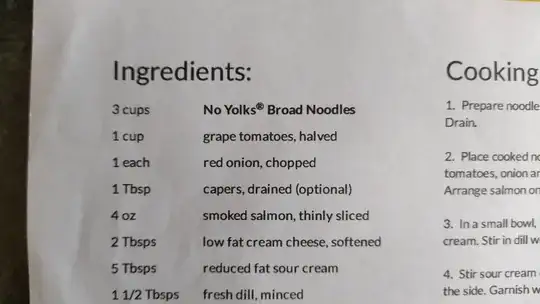It really doesn't matter.
First off, I think that it is worth discussing whether or not it really does matter. From the looks of the recipe, it appears that you are putting together some kind of noodle salad—cooked and cooled noodles, some veggies and fish, and a dressing. There is no real chemistry going on here, hence the recipe is going to be very forgiving in terms of quantities of ingredients used. "One red onion" is a very inexact measure (and a red onion 40 years ago is probably half the size of a red onion today), and a cup of grape tomatoes (measured either before or after chopping) could vary quite a bit, depending on the size of the tomatoes you get your hands on. Personally, I would likely use significantly more salmon, as well—in my very rural community, I'll be lucky to find smoked salmon at all, let alone a 4 oz package; I'll use whatever I can buy.
Basically, the rough, inexact nature of the recipe is a reflection of the fact that these measurements don't really matter. Use as much or as little as suits your taste.
But what if it does?
As moscafj points out, if it really mattered, then the recipe would likely have been written more clearly. Instead of using volumetric measure, the recipe would have given a weight or mass (e.g. I would guess that a cup of halved grape tomatoes is probably somewhere around 6–8 oz), or perhaps a (slightly less precise, but still useful) count (such as "12 grape tomatoes, halved").
That being said, the construction of the ingredient list should tell you what's going on (assuming that the recipe's author thought about this at all). The ingredient is given as
- 1 cup grape tomatoes, halved.
This is a distinct instruction from
- 1 cup halved grape tomatoes.
In the first case, I would measure out a cup of grape tomatoes, then halve them. In the second case, I would halve grape tomatoes until I had filled a one cup measure.
Note that both of these constructions are relatively common. Standard, even. In most professionally edited recipes,
- [measurement] [ingredient], [modification]
means "measure the ingredient, then do something to it"; whereas
- [measurement] [modification] [ingredient]
means "do something to the ingredient, then measure the modified ingredient".
Indeed, I have a brownie recipe which uses both: it calls for "1/2 c chopped walnuts" and "1 c semisweet chocolate chips, melted". In the first case, chop the nuts, then measure them. In the second case, measure the chocolate chips, then melt them (and the actual procedure reinforces this interpretation).
What should you actually do with this recipe?
With this recipe, my game plan would be as follows:
- grab a measuring cup, a knife, a cutting board, and some tomatoes
- measure the tomatoes into the cup; eat a few and refill the cup
- dump the cup out onto the cutting board and start halving the tomatoes
- eat a few tomatoes; grab a few more out of the bag to replace those that I have eaten
- prepare the other ingredients, eating a few halved tomatoes as I go
- halve more tomatoes as replacements
- notice that my original container of tomatoes is almost empty; halve the remains, eat a few, and throw the rest into the recipe for good measure
